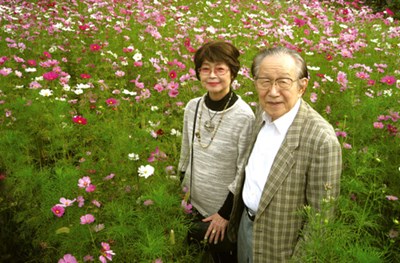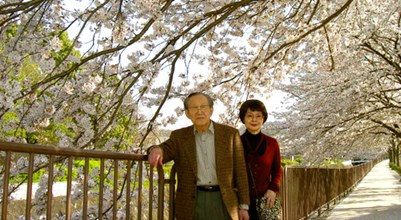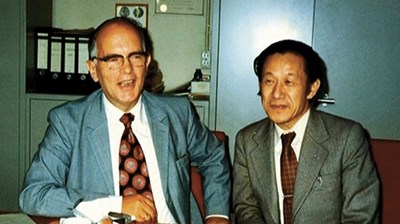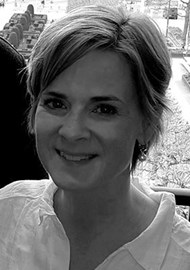A 90th birthday is definitely a landmark that should be observed and celebrated. Elisabeth Sjögren interviews this man who has been such a huge influence in the world of laryngology.

Nobuhiko and Keiko in the cosmos field.
Congratulations on your upcoming birthday. Any special plans for that day?
I have no special plans for that date. But I have heard that my colleagues are planning a party to celebrate!
At 85 you were still working several days a week. How about now? Any project still going on?
I myself am not working but I’m consulting with other doctors on some special cases.
In an earlier interview you spoke about wanting to become a physicist or a mathematician, but you ended up going to medical school. How did you then come to follow a career in ENT and phonosurgery?
ENT was close to mathematics and physics; therefore I shared my interest with many friends in ENT. I published a lot of papers in ENT and phonosurgery which attracted many patients.
You were working on computer simulations of pathological vocal fold vibration, already in the mid-70s. It seems like you were able to combine your interest in basic science with your career in medicine. Do you think this interest helped you to develop as a surgeon?
Yes, a little. The interest was greatly helpful as a researcher rather than as a surgeon.
The famous Isshiki thyroplasty procedures: what problems were you experiencing in phonosurgery that inspired you to design these techniques?
In order to make the window in the right place I wanted to minimise the surgical field and scars. If the window was made in the wrong place, the voice would not be improved, but rather aggravated.
“The most important thing in the therapeutic process is to make a detailed and conclusive inquiry into the pathological situation”
Looking at type I thyroplasty, there are so many variations of implant material and design being used. Each phonosurgeon has his own favourite type and adaption. Do you think that there is still one optimal design out there, yet to be determined? Or do they all work?
Each phonosurgeon would perform the best method based on own surgical experiences. I hope that the details of the surgical procedure will be improved by individual surgeons. In my experience so far, the most adaptable material for the phonosurgery is titanium.
What is your opinion on the role of arytenoid adduction in the treatment of paralysed vocal fold? Could it have been the ‘Isshiki type V’ as an additional tensioning procedure?
I don’t know whether the surgery is commonly called the ‘Isshiki type V’ or not - there are surgical procedures that tense the vocal cords to make the voice higher, but this one is somewhat difficult. There are several surgical methods for tensing the vocal cords, such as extending the anterior-posterior length of the thyroid cartilage or extending the vocal cords by simulating the cricothyroid muscle (anterior muscle).
In my opinion on arytenoid adduction in the treatment of paralysed vocal cords, it is necessary to operate in a sufficiently wide area, not a narrow area. My recent procedure is to check the internal condition by temporarily removing one of the thyroid cartilage ala. Partial and temporary removal of a wing of the large part of the thyroid ala is quite easy and restorable.
After the surgical procedure is complete, return the thyroid cartilage ala to its original position and secure it with a thread.
Surgery can be performed while checking the location of important organs such as internal muscles, nerves, and blood vessels.
This is relatively safe way.

Nobuhiko and Keiko and the cherry trees near their house.
I am curious to know, what in your opinion is the biggest challenge left today in phonosurgery?
The answer is simple, but it is difficult to cure the patient’s voice to the preferred condition. Because each patient has different voice preferences and different conditions in the larynx, surgeons have to experience a lot of surgery.
What is the most important thing that you have learned in your career and what has given you the most satisfaction?
The most important thing in the therapeutic process is to make a detailed and conclusive inquiry into the pathological situation. I have been most impressed when a patient, whose voice had not improved for a long time despite various medical treatments but is finally restored after surgery, deeply expresses his great appreciation.

Prof Isshiki with Prof Jan Willem van den Berg (Mathematical Physicist) at his University in Amsterdam.
Who has been the greatest influence throughout your career?
Prof Jan Willem van den Berg has been the greatest influence on my research. He analysed the trajectory of the vocal cords’ movement physically and mathematically. The mechanism of voice production has been clarified in an easy-to-understand manner, so as to be applicable in medicine. I have been to his college and showed him my original film, Laryngeal framework surgery - Isshiki, presented at the congress in New York. I told him that this work was based on his research. He seemed to be very proud of me and made me very happy.
If you had to do it all again would you have done anything differently?
I can’t think of anything I would have done differently. I am satisfied with my life. My life has been led by many people I met. I thank all the people, and especially my wife who passed away three years ago. She spent eight years fighting lung cancer, but she was peaceful during her time. I would like to learn from her and spend my days like that.
What advice do you have for young doctors today?
It is difficult to challenge existing and accepted practice, but I hope young doctors will do their own original research.





